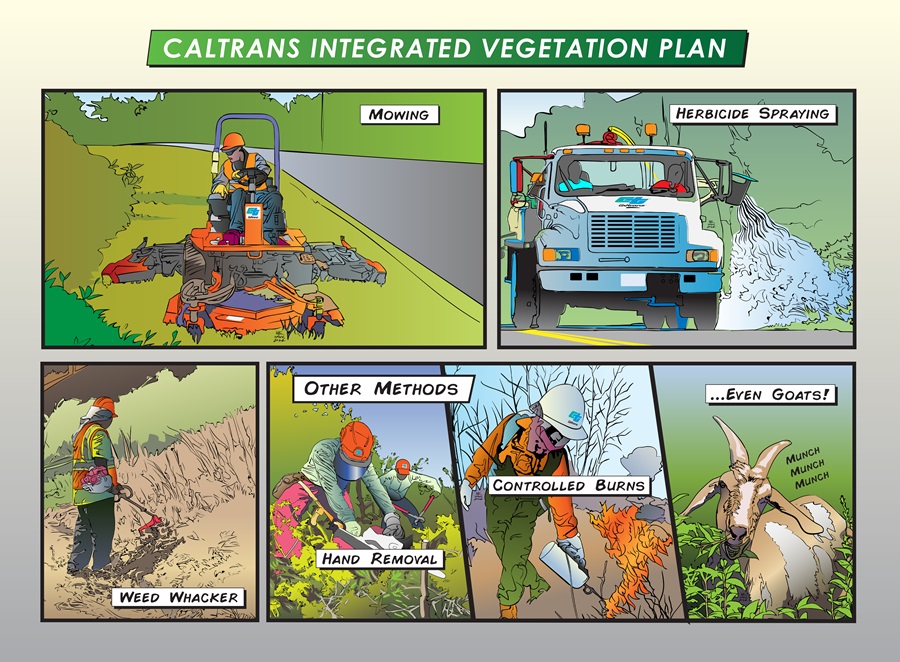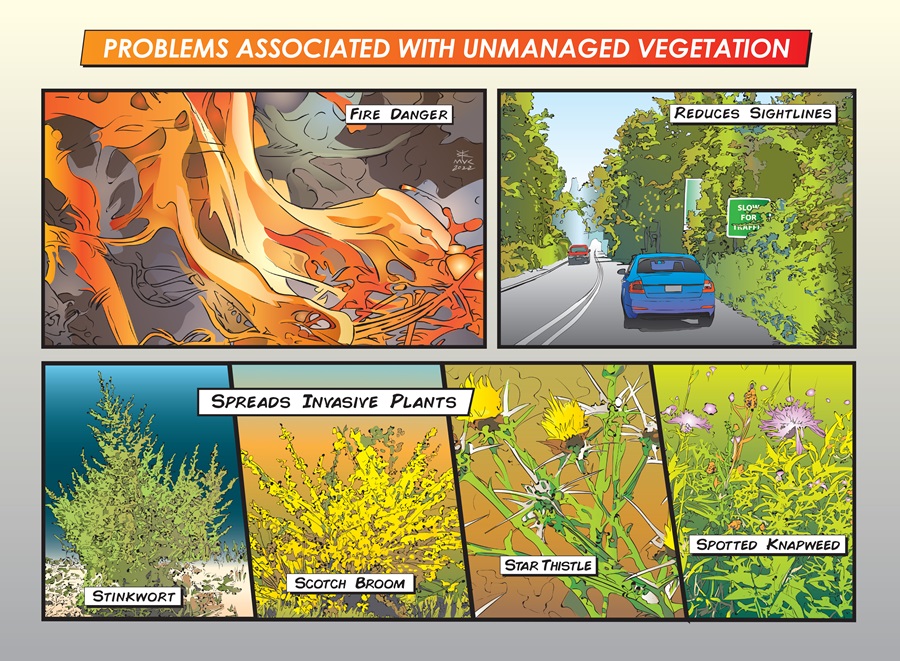Roadside Vegetation Control
Vegetation Management Reduces the Risk of Wildfire and Increases Safety for Motorists, Cyclists and Pedestrians
Roadside Vegetation can become fuel for wildfire, impair sight distances, and spread invasive plants

Caltrans controls the vegetation along the state highways for the safety of motorists, cyclists, and other users of state roads, and to prevent wildfires that can start if dried grass and brush are allowed to go untended along the road.
To control vegetation, Caltrans implements a plan called the Integrated Vegetation Management Plan (IVP) composed of assorted methods for keeping vegetation in check, including herbicide spraying, mowing, weed whacking, hand removal. Even goats have been used along state highways to reduce brush.
Tall grass and weeds create serious problems for motorists by decreasing visibility, block traffic signing, and reducing sightlines impeding the ability to see oncoming traffic around bends in the road. This can be especially problematic on winding rural or semi-rural routes where cyclists often use the road.
During the dry months, vegetation along the shoulders turns dry, becoming an ample fuel for fires. A car bottoming out, a trailer chain dragging on the road even the friction of roadway rocks hitting other rocks on the shoulder can send a spark into the dry weeds, igniting the next wildfire.
Caltrans has been especially vigilant in recent years given the frequency and scale of California’s wildfire.
Invasive plants such as stinkwort, star-thistle and spotted knapweed thrive along the highways.
Caltrans uses herbicide on these invasive weeds due to the plants' tenacity and because mowing or weed trimming exacerbates the problem by spreading the seeds.
During the summer, vegetation along the shoulders turns brown and dry, an ample fuel for fires. A car bottoming out, a chain from a trailer dragging on the road can send a spark into the dry weeds, igniting the next wildfire.
Unchecked grass, weeds and brush, rise above the road, blocking roadway signs, and diminishing sightline, making it difficult to see oncoming traffic around bends in the road.
Additionally, many invasive plants thrive in the soil next to the shoulders, their seeds spread by the wind and passing traffic.
To combat these challenges, Caltrans implements a program called Integrated Vegetation Management (IVM), a practice using several methods of vegetation control, including herbicides, mowing, weed whacking and hand removal. Even goats have been used along state highways to reduce brush.
Over the past decade, Caltrans has greatly reduced its reliance on herbicides to control vegetation. However, there are situations where herbicides are used for worker safety and control of invasive plants.
Caltrans workers are trained to follow federal and state laws pertaining to pesticide use. All herbicides are used in accordance with their respective federal label, California Code of Regulations, as well as Caltrans policy.
Caltrans typically sprays herbicides in areas where the safety of Caltrans workers might be jeopardized by fast moving traffic or lack of visibility.
Invasive plants such as stinkwort and scotch broom thrive along the highways where it competes with local vegetation. In locations where stinkwort or scotch broom thrive, herbicide is used because of the plant's tenacity and because mowing or weed trimming exacerbates the problem by spreading the seeds.
Herbicides
- The herbicide most used by Caltrans is glyphosate (Roundup).
- When applying herbicides, Caltrans follows strict protocols, including leaving buffer zones adjacent to creeks, wetlands, waterways and drainage outlets.
- Likewise, Caltrans maintain buffer zones around private driveways and mailboxes. Caltrans reviews its policies of herbicide application every year to keep current with best policies of managing vegetation along state highways.
- Some counties have ordinances against government use of glyphosate, aka Roundup, for weed control. As a state agency, Caltrans is not bound by the regulation and uses glyphosate when necessary. But the Caltrans Bay Area is always looking for alternatives.
Caltrans sprays herbicide on weeds to...
- Create a fire barrier: Caltrans consults with local fire departments to prevent fires along the roadway. The best way to do this is to eliminate weeds and brush, which dry out, become a fire hazard
- Enhance safety: Tall weeds can obscure traffic signs and impair visibility, especially on curves.
- Control invasive species: The worst invader might be stinkwort, a Mediterranean native that first appeared in California (Santa Clara County) in 1984. Other invaders are French and Scotch broom, spotted knapweed, star thistle, pampas grass.

Where and When Caltrans Sprays and Doesn’t Spray
- The herbicide spray fans out, extending about 4-feet from the edge of the shoulder or pavement.
- The right of way extends at least 8 feet from the edge of shoulder/pavement
- Areas where Caltrans does not spray: Wildlife habitat, schools, creeks, driveways and congregated mailboxes
- Caltrans will not spray when wind speeds are 10 mph or higher
- Caltrans spraying vehicles maintain a slow speeds to prevent drift.
Integrated Vegetation Management
- Integrated Vegetation Management (IVM) is a system used by Caltrans in which several options for controlling vegetation are considered to achieve the best results.
- Primary methods of weed abatement include, mechanical, manual, chemical thermal, biological, cultural and structural. More than one method can be combined and incorporated in a successful program
- Safety of Caltrans employees are of paramount concern. Thus most work will be done from vehicles rather than on foot.
- Despite the integrated approach, bare ground will always be a better barrier to fire than a surface of mowed weeds, thus in many cases, spraying will be used
- Caltrans will not use discs to plow the roadside because it stirs up the soil and creates run-off that puts silt in creeks, destroying fish habitat
Herbicides
- The herbicides Caltrans uses are registered with the Environmental Protection Agency and the California Department of Pesticide Regulation. Caltrans reviews its list and approves the use of the herbicides, including Glyphosate.
- Pre-emergent herbicide is used to prevent the germination of seeds by inhibiting a key enzyme. It won’t harm established plants, so it is typically used on lawns to prevent crab grass.
- Post-emergent herbicide is herbicide that is used after the plant has emerged from the ground
- All pesticides used by Caltrans have been approved for use by the Federal and State Government; the Environmental Protection Agency and California Environmental Protection Agency
- Glyphosate (Round Up and other herbicide products) is included on the list of Prop. 65 chemicals as likely carcinogen
- Many chemicals on the Prop 65 list are used for various purposes throughout the state. In other words, Prop 64 does not preclude the use of glyphosate for weed control
- Glyphosate becomes inert almost immediately when it contacts the soil. It binds with the soil, losing potency
- Inquiries about pesticide can be directed to EPA, Cal EPA or manufacturers. While Caltrans knows much about the herbicide we use, we are still the end user, following the environmental laws. The manufacturer and state and federal environmental agencies will know much more about the chemistry of these products
Links
EPA Webpage on glyphosate: https://www.epa.gov/ingredients-used-pesticide-products/glyphosate

